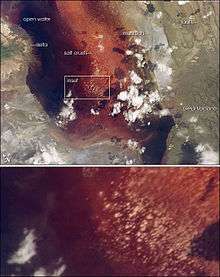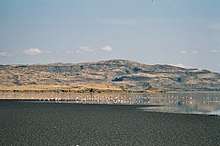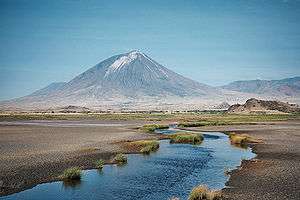Lake Natron
Lake Natron is a salt or soda lake in Arusha Region in Tanzania. It is in the Gregory Rift, which is the eastern branch of the East African Rift.[1] The lake is within the Lake Natron Basin, a Ramsar Site wetland of international significance.[2]

| Lake Natron | |
|---|---|
_%E2%80%93_2017-03-06_(very_early_in_rainy_season)_%E2%80%93_satellite_image_(cropped).jpg) The lake on 6 March 2017 (satellite image) | |
 Lake Natron | |
| Location | Northern Tanzania |
| Coordinates | 02°25′S 36°00′E |
| Lake type | saline |
| Basin countries | Tanzania |
| Surface elevation | 600 metres (2,000 ft)[1] |
| Official name | Lake Natron Basin |
| Designated | 4 July 2001 |
| Reference no. | 1080[2] |
The lake is fed principally by the Southern Ewaso Ng'iro River, which rises in central Kenya, and by mineral-rich hot springs.[1] It is quite shallow, less than three metres (9.8 ft) deep, and varies in width depending on its water level. The lake is a maximum of 57 kilometres (35 mi) long and 22 kilometres (14 mi) wide.[1] The surrounding area receives irregular seasonal rainfall, mainly between December and May totalling 800 millimetres (31 in) per year.[1] Temperatures at the lake are frequently above 40 °C (104 °F).[1]
High levels of evaporation have left behind natron (sodium carbonate decahydrate) and trona (sodium sesquicarbonate dihydrate). The alkalinity of the lake can reach a pH of greater than 12. The surrounding bedrock is composed of alkaline, sodium-dominated trachyte lavas that were laid down during the Pleistocene period. The lavas have significant amounts of carbonate but very low calcium and magnesium levels. This has allowed the lake to concentrate into a caustic alkaline brine.[3]
Flora
The color of the lake is characteristic of those where very high evaporation rates occur. As water evaporates during the dry season, salinity levels increase to the point that salt-loving microorganisms begin to thrive. Such halophile organisms include some cyanobacteria that make their own food with photosynthesis as plants do. The red accessory photosynthesizing pigment in the cyanobacteria produces the deep reds of the open water of the lake and the orange colors of the shallow parts of the lake. The alkali salt crust on the surface of the lake is also often colored red or pink by the salt-loving microorganisms that live there. Salt marshes and freshwater wetlands around the edges of the lake do support a variety of plants.
Fauna

Most animals find the lake's high temperature (up to 60 °C [140 °F]) and its high and variable salt content inhospitable.[4] Nonetheless, Lake Natron is home to some endemic algae, invertebrates, and birds. In the slightly less salty water around its margins, some fish can also survive.
The lake is the only regular breeding area in East Africa for the 2.5 million lesser flamingoes, whose status of "near threatened" results from their dependence on this one location. When salinity increases, so do cyanobacteria, and the lake can also support more nests. These flamingoes, the single large flock in East Africa, gather along nearby saline lakes to feed on Spirulina (a blue-green algae with red pigments). Lake Natron is a safe breeding location because its caustic environment is a barrier against predators trying to reach their nests on seasonally forming evaporite islands. Greater flamingoes also breed on the mud flats.
The lake has inspired the nature documentary The Crimson Wing: Mystery of the Flamingos by Disneynature, for its close relationship with the Lesser flamingoes as their only regular breeding area.
Two endemic fish species, the alkaline tilapias Alcolapia latilabris and A. ndalalani, also thrive in the waters at the edges of the hot spring inlets. A. alcalica is also present in the lake, but is not endemic.
Threats and preservation
The area around the salt lake is not inhabited but there is some herding and some seasonal cultivation. Threats to the salinity balance from increased siltation influxes will come from more projected logging in Natron watersheds and a planned hydroelectric power plant on the Ewaso Ng'iro across the border in Kenya. Although development plans include construction of a dike at the north end of the lake to contain the freshwater, the threat of dilution to this breeding ground may still be serious. There is no formal protection.
A new threat to Lake Natron is the proposed development of a soda ash plant on its shores. The plant would pump water from the lake and extract the sodium carbonate to convert to washing powder for export. Accompanying the plant would be housing for over 1000 workers, and a coal-fired power station to provide energy for the plant complex. In addition, there is a possibility the developers may introduce a hybrid brine shrimp to increase the efficiency of extraction.

According to Chris Magin, the RSPB's international officer for Africa, "The chance of the lesser flamingoes continuing to breed in the face of such mayhem are next to zero. This development will leave lesser flamingoes in East Africa facing extinction". Seventy-five percent of the world's lesser flamingoes are born on Lake Natron.[5] Currently a group of more than fifty East African conservation and environmental institutions are running a worldwide campaign to stop the planned construction of the soda ash factory by Tata Chemicals Ltd of Mumbai, India and National Development Corporation of Tanzania. The group working under the umbrella name Lake Natron Consultative Group is being co-ordinated by Ken Mwathe, Conservation Programme Manager at BirdLife International's Africa Secretariat.
As per communication on June 2008, Tata Chemicals shall not proceed with the Natron Project and further re-examination of this project will be subject to the Ramsar Wetlands plan, which is currently under preparation.[6]
Because of its unique biodiversity, Tanzania named the Lake Natron Basin to the Ramsar List of Wetlands of International Importance on 4 July 2001. The lake is also the World Wildlife Fund East African halophytics ecoregion.
Visiting the area
There are a number of campgrounds near the lake, which is also the base for climbing Ol Doinyo Lengai. Lake Natron has immense tourist attraction potentials that are important for ecotourism development. However, lack of a general management plan, inadequate funding at the operational level, lack of mechanisms to secure a fair distribution of ecotourism benefits, and poorly developed tourism infrastructural facilities to support diverse segments of tourists were identified as the main challenges associated with the management of ecotourism in the area.[7]
References
- "Eastern Africa: Northern Tanzania, on the border with Kenya". World Wildlife Fund.
- "Lake Natron Basin". Ramsar Sites Information Service. Retrieved 25 April 2018.
- "Alkaline Environments", authored by W. D. Grant and B. E. Jones, in Encyclopedia of Microbiology, editor-in-chief Joshua S. Lederberg, Academic Press, 2010, page 129, accessed 24 November 2014
- Swancer, Brent (20 April 2015). "The Bizarre Medusa Lake of Africa". Retrieved 1 June 2019.
- Billock, Jennifer (14 June 2016). "The Deadly Lake Where 75 Percent of the World's Lesser Flamingoes Are Born". Smithsonian. Retrieved 17 June 2016.
- "Position Statement on the Lake Natron Project" (PDF). Tata Chemicals. 13 June 2008. Archived from the original (PDF) on 5 October 2013. Retrieved 7 October 2013.
- Shoo, Rehema Abeli (2020), "Ecotourism Potential and Challenges at Lake Natron Ramsar Site, Tanzania", Protected Areas in Northern Tanzania, Springer International Publishing, pp. 75–90, ISBN 978-3-030-43301-7, retrieved 30 May 2020
External links
| Wikimedia Commons has media related to Lake Natron. |
- LakeNet Profile
- Think Oink – Save Africa's Flamingos
- NBC article about Nick Brandt's photos of petrified animals at Natron lake
- "Lake Natron, Tanzania". Earth Observatory Newsroom. Archived from the original on 1 October 2006. Retrieved 17 April 2018.
- "East African halophytics". Terrestrial Ecoregions. World Wildlife Fund.